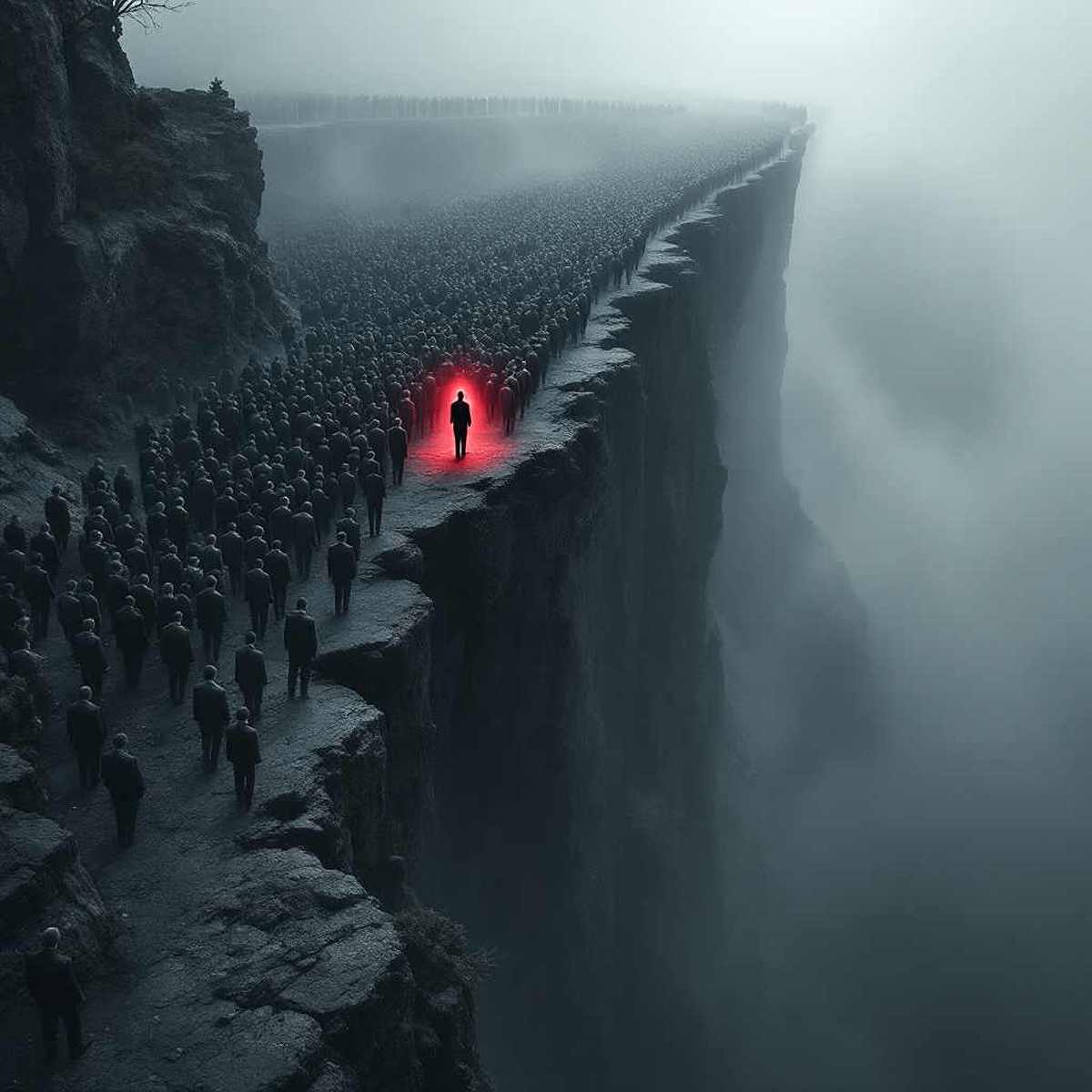Market Bottom: Fools Try to Predict It, the Wise Position Quietly
May 21, 2025
Introduction: How to Miss a Sunset: The Glow Always Comes Too Late
There’s a kind of madness that grips certain hikers at dusk.
They reach the summit, panting, triumphant. But their eyes are already scanning the horizon—not to admire the view, but to catch it. That last sliver of light, that golden flash before the world tilts into blue. You’ve seen them. Cameras out, adjusting ISO like they’re cracking safe codes. Feet shifting. Breath held. Everything hangs on the final moment.
And it always slips past. The glow doesn’t peak where they thought. The clouds reflect incorrectly. The tree line cuts the angle. It’s over.
But they stay. Frozen. As if stillness could rewind time. As if reverence could summon that one final photon back.
It never does.
Because sunsets don’t give you closure, they fade.
The Lure of the Perfect Exit
What no one tells you about these sunset-chasers is how quiet the descent becomes. After all that tension and positioning… there’s just the hush of boots scraping gravel. The rush is gone. The camera battery’s dead. And now you’re walking down a cold ridge in the dark.
The irony is thick: while trying to capture the most glorious light, they missed everything else: the breeze before the dip, the shifting colour on stone, and the murmur of birds settling into silence.
The whole show is gone because they were hooked on a finale that doesn’t exist.
The moment you try to hold a perfect ending is when you begin losing the story.
Flinch, Freeze, Fall
Investors do this too.
They stand at the edge of a market bottom, desperate to time the flicker. Not to understand it. Not to move with it. To catch the mythical last tick before reversal. The exact low.
They chart. They screen. They scroll for confirmation bias in twelve flavours.
And when the market does finally turn… they hesitate. They flinch. What if this isn’t the real glow? What if there’s another dip? What if—what if—what if—
And the bottom… becomes the past.
Not because it was hard to see. But because they couldn’t move without guarantees.
Like hikers who won’t take a step until the colour hits just right.
By the time they believe it’s safe, the trail is empty. The price has already climbed. The breath they were holding turns into a sigh, then silence.
They’re Not Wrong, Just Miswired
Let’s pause here.
These people aren’t dumb. They’re precise, analytical, and often deeply thoughtful. But they’ve confused precision with control. They think the perfect entry is an earned reward for patience. That if they wait long enough, they’ll be given certainty.
But bottoms aren’t awarded. They aren’t certified. They’re psychological breaking points—murky, volatile, invisible until they pass.
What’s maddening is that bottoms don’t feel like opportunities. They feel like failure, like risk compounding, like maybe it never comes back.
That’s why the real inflexion points are almost always obvious after. In real time, they feel like jumping off a cliff blindfolded.
The market knows this, and it feeds on it. The longer you hesitate, the more it runs.
Dead Air, Then Roar
Look back at 1932. Nobody rang a bell. The bottom came with a whisper, not a bang. The Dow had bled nearly 90% from its highs. Breadlines stretched for blocks. Industrial production had collapsed by half. Banks weren’t just failing—they were vanishing, overnight, taking life savings with them. Roosevelt wasn’t even in office yet. There was no policy rescue, no coordinated bailout—just dust, desperation, and silence.
Who had the gall to buy when everything smelled like death?
Or March 2009. The S&P was haemorrhaging, down over 50%. General Motors teetered on extinction. Lehman was already a tombstone. AIG, Citigroup, and Fannie Mae were zombie institutions kept upright with duct tape and denial. CNBC became a funeral home. Bank of America was trading under $4. The VIX read like a scream.
Then, without ceremony, the market turned.
Not because confidence returned. It didn’t.
But because despair had maxed out. Sellers were exhausted. Even the pessimists ran out of ammo.
The same happened in March 2020: COVID lockdowns. ICU footage looped like horror cinema. Oil collapsed below zero, negative pricing. Airports were deserted. The Nasdaq shed hundreds of points by the hour. Companies yanked guidance. Corporate debt markets froze. The Fed panicked. Treasury yields evaporated. You could almost hear the collective gasp of investors clutching cash like it was oxygen.
And yet—again—in the middle of a global psychosis, the floor hardened.
Why?
Because the selling climaxed, because the panic hit a saturation point, and fear had nowhere else to go but silence.
This pattern repeats: not in form, but in sensation.
1974: stagflation, Watergate, oil embargo. The bottom arrived in October like a thief at dawn.
1987: a 22% single-day crash. But within days, the tape stabilised, even as headlines stayed apocalyptic.
2002: the dot-com burial. Enron, WorldCom, 9/11 aftermath. But by late ’02, the market began crawling upward while the narrative still wheezed with disbelief.
Every major bottom is shrouded in dead air—a vacuum. No celebrations. No parades. Just the absence of more bad.
Then something shifts—not loud, not clean—a trickle of buying, a few higher lows, a fade in volatility.
And that’s the tell: not hope, not reason—momentum’s reappearance in a desert of disbelief.
No indicator blinks green. No guru confirms it.
Just price… shifting weight. Tentatively. Then defiantly.
Because markets don’t wait for you to feel safe.
They move when you feel nothing.
When Silence Is the Tell
Here’s the uncomfortable truth: the bottom never feels like a bottom. It feels like betrayal.
The news is still negative. Analysts are still downgrading. Social sentiment is radioactive. Everything looks wrong.
But the tape… starts acting different.
There’s volume without news. Panic selling slows. Low-beta names twitch green. The silence becomes textured. Not relief—tension. The kind you feel in a theatre before the lead takes the stage.
And if you wait for permission? You miss it.
That’s the nature of bottoms. They’re stealth moves. They punish hesitancy and reward discomfort.
The Last Buyer, The First Ghost
Chasing the exact low is like trying to take the last sip of coffee without tilting the mug. You want maximum gain, minimum risk, no mess.
But the one who buys the bottom? They don’t know it’s the bottom. They act.
Not recklessly—but decisively.
They are small. They scale in. They accept pain. They move.
You don’t catch the bottom. You bleed into it. You survive long enough for the pain to make sense—and the price to make nonsense.
And by the time you’re sure it’s over, the alpha’s gone.
Why You Don’t Feel Ready
You’re not wired to buy bottoms. Your brain is a pattern-recognition machine trained in trauma. It stores the last crash like a scar. It whispers: “Don’t move yet. Wait until it’s obvious.”
But by the time it’s obvious, it’s over.
The irony is that the best trades feel awful at entry. And euphoric entries? Often rot from the inside.
So you wait. You pray for one more dip. One more flush. One more sunset before the light fades.
And the market doesn’t care.
It’s already moving.
It Was Never the Glow That Mattered
Back to the ridge.
You’re alone now. No one’s chasing light. The wind’s picked up. The path is narrow, but it’s yours. And suddenly, the absence of light—of need—feels like freedom.
Maybe the real victory isn’t catching the sun, but knowing when to turn and go.
Before it’s too late.
Before the light becomes a memory you mistake for truth.











